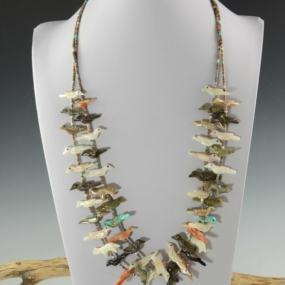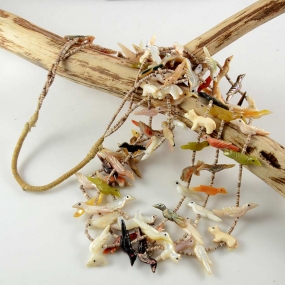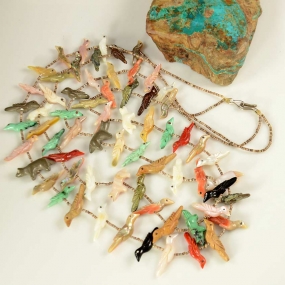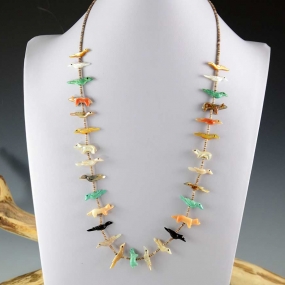
We recently found a David Tsikewa Bio written by Ruth Kirk on the Adobe Gallery website. The information is truly a treasure! Don and Nita Hoel were also great admirers, appreciators and collectors of his work. We are still collecting and representing David Tsikewa and his family’s work in our gallery.
David Tsikewa (1915-1971) brought a previously unseen delicacy to the art of fetish carving. His pieces have a sweet, gentle quality that distinguishes them from the works of his contemporaries.
 Tsikewa came from a relatively small family by Zuni standards. Lugya, his father and mother, had three other children, Lorna Quam (sister-in-law to famed jeweler Annie Gasper Quam), Ida Eriacho, and Sadie Epaloose. Tsikewa and his wife Mary had eight children of their own: Bill, Delano, Lavina Kaskalla, Jennie, Rudolph (Rudy), David Jr., Marvin, and Annette. Born in 1915, David passed away from a heart attack in 1970.
Tsikewa came from a relatively small family by Zuni standards. Lugya, his father and mother, had three other children, Lorna Quam (sister-in-law to famed jeweler Annie Gasper Quam), Ida Eriacho, and Sadie Epaloose. Tsikewa and his wife Mary had eight children of their own: Bill, Delano, Lavina Kaskalla, Jennie, Rudolph (Rudy), David Jr., Marvin, and Annette. Born in 1915, David passed away from a heart attack in 1970.
Tsikewa learned silversmithing from the renowned Horace Iule in about 1937 and appears on John Adair’s 1940 census as a silversmith under the name David Siaekewa. He made inlay butterflies and by the late 1940s was known for special order items, particularly bolos and buckles, in which he used turquoise to work customers’ names in channel inlay. Dude Kirk, Gallup, NM Indian trader, marketed most of Tsikewa’s work at that time. In the mid-1940s, Ruth Kirk asked him to carve birds to be strung on necklaces, which was the beginning of Tsikewa’s beautiful and delicate fetish necklaces.
Although he never gave up silversmithing completely, and in later years did inlay for Hopi/Mission jeweler Preston Monongye, by the mid- to late-1950s Tsikewa emphasized carving. He continued to make jewelry for Dude Kirk and Charles and Pat Kelsey, while also stringing and carving free-standing fetishes for Leon and Ruth Ingraham, the Kirks, C. G. Wallace, and Joe Tanner. In 1959 Tanner, who considers Tsikewa to have been his best friend at Zuni Pueblo, commissioned him to make the pieces for a chess set. One of Tsikewa’s most elaborate creations ever, the set includes a board with inlaid squares of white shell and turquoise by Francis Leekya, the son of Leekya Deyuse. In 1966 Tanner organized the Heard Museum’s Zuni Show, which featured Tsikewa’s work. Tanner bought stringing fetishes from Tsikewa for a dollar apiece and had them custom-made into necklaces for buyers at the show.
Tsikewa’s daughter Lavina maintains that no one specifically taught him to carve, but his son Bill says that he was influenced by father-in-law Teddy Weahkee. Tsikewa at first worked with hand tools, but quickly converted to electric tools which enabled him to achieve the delicacy for which his carvings are known. Tsikewa earned his living almost exclusively through his art. According to his son he sometimes signed his fetishes with his cattle brand, a “spear D.” A silver tag stamped “David” often adorned his fetish necklaces.
 David Tsikewa’s fetishes range from fairly simple to quite detailed. His strung fetish birds display a unique angle to the wing that distinguishes them from birds made by the rest of his family. His four-footed creatures give the impression that they are coming to a quick stop. Most have darkened, drilled eyes and few have bundles. In almost all cases, Tsikewa’s approach is exemplified by beautiful polishing. He also carved animals that were uncommon for the time, producing probably the largest menagerie of any carver in his era. On rare occasions Tsikewa, like some of his peers, created detailed human figures.
David Tsikewa’s fetishes range from fairly simple to quite detailed. His strung fetish birds display a unique angle to the wing that distinguishes them from birds made by the rest of his family. His four-footed creatures give the impression that they are coming to a quick stop. Most have darkened, drilled eyes and few have bundles. In almost all cases, Tsikewa’s approach is exemplified by beautiful polishing. He also carved animals that were uncommon for the time, producing probably the largest menagerie of any carver in his era. On rare occasions Tsikewa, like some of his peers, created detailed human figures.
Today, David Tsikewa’s family continues his tradition. His wife Mary made fetishes until her death in 1986. Their children all carved fetishes, and some even bested their father’s work in juried art shows. This proud family heritage remains with Bill, Lavina, Jennie, and Annette, who still produce diverse, top-quality work.
Biography from Ruth Kirk







